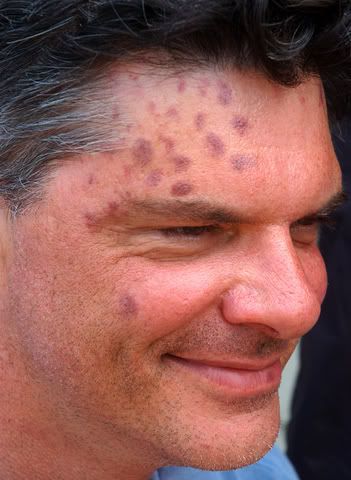Submarinista Vs Pulpo -The Octopus Tattoo-
Published Friday, July 07, 2006 by Spyder | E-mail this postArtículo que narra las vivencias de un submarinista que sufrió el acoso de una pulpo. La imagen habla por si sola...
 The Octopus Tattoo
The Octopus TattooI floated 55 ft below the surface of the Strait of Juan de Fuca, sketching a beige sculpin that I did not recognize, when I saw a strand of red kelp drifting by. I noticed a line of white suckers running along it. Next something heavy dumped on my head. Another tentacle with delicate suckers curled in from below and pulled my mask away from my face, flooding it. I felt other tentacles squeeze the right side of my face and pull on my hood. I'd last seen my dive buddy peering into a crevice -- he didn't appear, although I turned around a couple times hoping he might take a photo. I tried to brush the octopus off my head, but he squeezed all the tighter.
When the octopus tried to pull my regulator out, the aggressive response took over. "OK, buddy, let's see how you like breathing air!" I drifted to the surface, maintaining the <60 ft/min safe ascent rate, and clearing my mask a couple of times on the way up to check. I surfaced with unusual headgear and saw the dive boat nearby. The octopus actually continued to squeeze my head, but finally my efforts to brush him off persuaded him to leave. I cleared the mask again and looked down to see him swimming away; only about 2.5 ft long. When the boat captain finally spotted me, he seemed not to believe my shouted explanation, but directed me to my buddy's bubbles. Once near the bottom, I checked off: 1 Giant Pacific Octopus.
I had always been curious about northwest diving, and the REEF fish-counting trip seemed like an ideal opportunity to try it. The diving was in the Olympic Coast National Marine Sanctuary, off the Makah reservation at the northwest corner of Washington State. REEF paid for the boat and lodging; we were responsible for transport, food, and air fills. Conditions were excellent: that meant flat water, sunshine, moderate to strong current, and 44 to 47 F water. My dive buddy, Stan Kurowski, wore a neoprene drysuit filled with argon (lower thermal conductivity than air) and inflatable dry gloves. With enough fleece underneath, my trilam drysuit seemed up to the cold, although my wet gloves were chilly: after 20 min my hands began to sting, and after an hour they really complained! I'd torn a wrist seal the day before meeting the octopus; Stan and Doug Biffard glued a seal from one of Stan's old dry gloves over the old one, saving my trip.
The above- and underwater landscape is volcanic, with big boulders, walls, and crevices. Sea palms and single-bladder nereocystis dominated the kelp forests. Although diversity of fish is less than Southern California, black rockfish, kelp greenlings, and ling cod were relatively plentiful and often huge. In the last minutes of my last dive there, I saw a wolf eel with a head the size of a dinner plate. Sculpins were far more diverse than in California, although usually hard to spot and identify. Small nudibranchs and giant plumose anemones were common. We saw many whales swim nearby above water, none below, although on a couple of occasions the people on the boat saw them blow less than 15 ft from our bubbles. The water was often thick with large and small krill, and in places the visibility was consequently less than a foot, although more commonly about 40 feet.
We took advantage of the great conditions to dive off Tattoosh Island, just off the northwest corner of Washington State, and even "around the corner" on the Pacific Coast of Washington State. Captain Troy Sterrenburg maneuvered his dive boat "Dash" skillfully through the live-boat drift dives, necessitated by changeable and sometimes stiff currents. The tides set our dive sites and times. Her stern ladder and jet drives gave us confidence in safe exits.
The Makah were celebrating Makah Days during our trip: the occasion for a parade, fireworks, and contests for several age categories of Ms. Makah. Posters featured ancestries of the candidates. Sanctuary Education Specialist Greg McCormack arranged some special events for us: we watched teenagers perform traditional dances at the gym, and an older Makah woman told us about earlier days, and the advent of schools and roads. The Makah were skilled hunters, and 8-man teams of specialists went after whales. Things are harder now, with less fishing, although I found some excellent smoked salmon.
When I climbed on the boat after meeting the octopus, Capt. Tory Sterrenburg laughed and reached for his camera. Small red hickeys covered a third of my face. The giant pacific octopus I met was one of two we counted; apparently the males are quite territorial, and will attack encroachers. The one I encountered was the most aggressive anyone on the boat had heard of. Trip leader Brice Semmens snapped a few photos.
I'd heard about the trip through REEF's AAT (Advanced Assessment Team) listserv. To become a subscriber, you must complete at least 50 REEF fish counts, and take the Level 4 or 5 multiple-choice examination on fish identification. REEF runs quite a few trips, with varying destination and costs; they provide opportunities for diving in unusual places, meeting interesting people, and -- yes! -- new tattoos.
See BlackCormorant.net for more photos from the trip.
Labels: Pesca



0 Responses to “Submarinista Vs Pulpo -The Octopus Tattoo-”
Leave a Reply